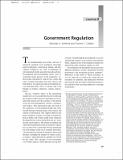Government Regulation
Author(s)
Ashford, Nicholas A.; Caldart, Charles
DownloadCH3_LevyWegman1.pdf (417.8Kb)
Metadata
Show full item recordAbstract
Abstract. Interest in the use of so-called voluntary approaches to supplement or replace formal environmental regulation is on the rise, both in Europe and in the United States. These approaches fall into two general categories: (1) industry-initiated codes of good practice focusing on environmental management systems or performance goals, and (2) negotiation between government and individual firms (or industry sector trade associations) focusing on regulation or compliance. This paper addresses the latter. In the United States, the motivations for engaging in such negotiation are manifold and sometimes contradictory. They include desires (1) to facilitate the achievement of legislated environmental goals by introducing flexible and cost-effective implementation and compliance measures, (2) to negotiate levels of compliance (standards) fulfilling health-based legislative mandates, (3) to negotiate legal definitions of Best Available Technology and other technology-based requirements, and (4) to weaken environmental regulation. In the United States, administrative agencies have long been experimenting with “negotiated rulemaking as a means of setting regulatory standards, and the Administrative Procedure Act was amended in 1990 to encourage further use of this process. U.S. agencies have also made frequent use of negotiation as a means of defining compliance responsibilities for individual firms. In addition, the Environmental Protection Agency (EPA) has sometimes acted outside of the authority given to it by its enabling legislation in an attempt to negotiate environmental policy and implementation. Two recent examples are the "Common Sense Initiative," in which EPA attempted broad-based negotiation focuses on particular industry sectors, and “Project XL", in which the agency attempted to negotiate flexible implementation of environmental requirements with individual firms. Although both programs are now moribund, each provides useful lessons for future efforts at environmental negotiation. This paper describes and analyses negotiated agreements in the United States in the context of EPA efforts to ensure environmental protection. These agreements can be described according to the following taxonomy: (a) negotiated regulation (either preceding formal regulation or as a substitute for formal regulation); (b) negotiated implementation (negotiations with an individual firm to establish the timetable and/or the means for meeting a particular regulatory standard; and (c) negotiated compliance (negotiation in the context of an enforcement action in which the firm is out of compliance with an applicable standard and there is an opportunity for extra-statutory environmental gains, such as encouraging cleaner production through the leveraging of penalty reductions). The criteria for evaluation used in this paper include: environmental outcomes, effects on stimulating technological change, time for development (time to completion), ease of implementation (likelihood of court challenge), stakeholder influence (ability of large firms to dominate outcome, environmentalists-industry balance of power), and administrative features.
Date issued
2005Citation
Occupational and Environmental Health: Recognizing and Preventing Disease and Injury, 5th ed.
Keywords
government, regulation